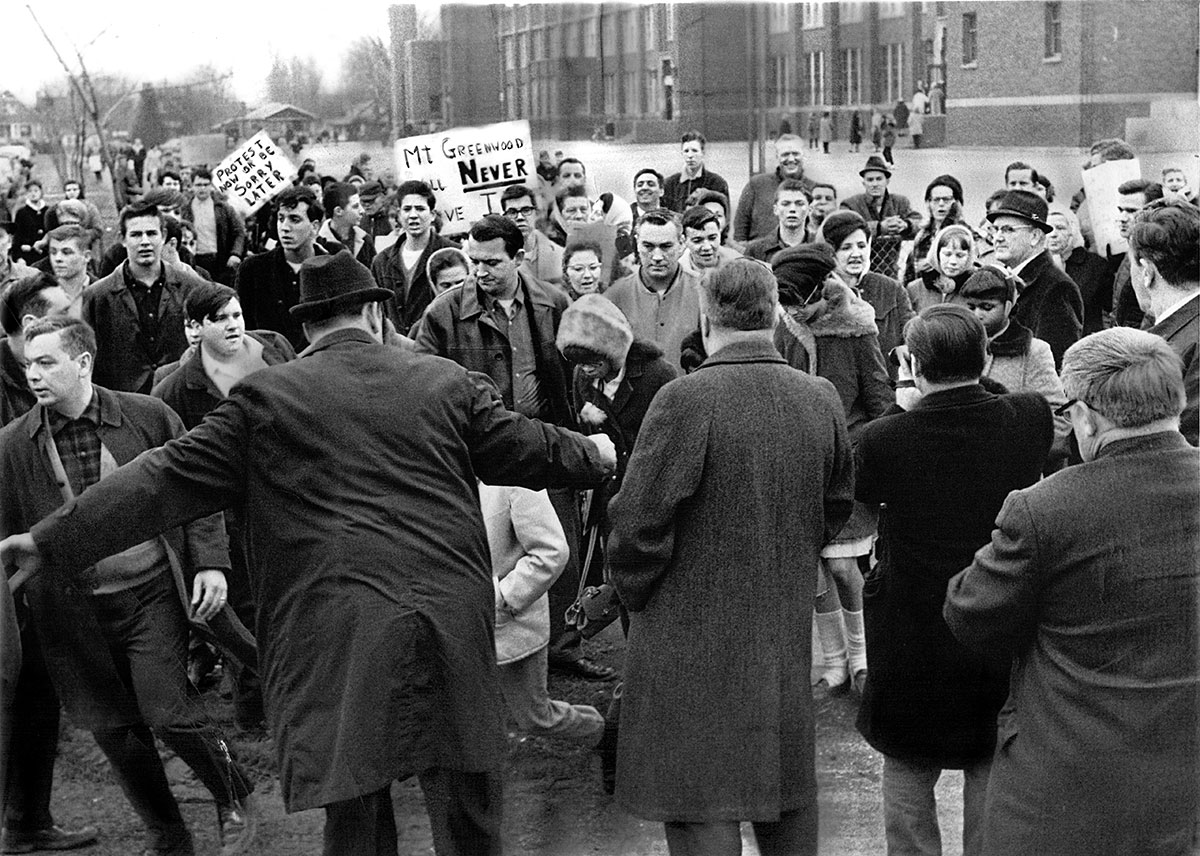
The students are escorted out of Mount Greenwood school on January 30, 1968.
Before the National Security Agency, in the United States, and the Communications Security Establishment, in Canada, there was the Red Squad, in Chicago. From the eighteen-eighties through the nineteen-seventies, this arm of the Chicago Police Department kept tabs on anarchists, labour activists, Communists and people thought to be Communist, civil-rights groups, and those who opposed the Vietnam War—political dissenters both militant and mild. The Red Squad’s techniques of overt and covert surveillance and infiltration were crude—even ham-handed—compared to those used in the modern digital age, but they were no less effective.
My parents knew, from comments made by employers and by the Red Squad’s less-than-subtle techniques, that they were in its records, even before the squad was shut down—after eleven years of litigation ending in a 1985 court decision—and its files released to a Chicago archive. My parents earned this distinction in the late nineteen-sixties, as they worked to support the desegregation of the public school in our white, conservative South Side neighbourhood, and independently produced an innovative program for preparing underemployed young black adults for lucrative jobs in the nascent computer industry. Those activities, though entirely lawful, all had negative repercussions: we were ostracized by our neighbours, our house was bombed, and my father was forced out of his job at I.B.M.
My family’s Red Squad files (I later learned I had a file too, despite being only sixteen at the time) don’t contain documentation of all of those activities, but the threat of surveillance—not to mention the actual reports sent to my father’s employer—made the Red Squad emblematic of those years, and coloured the rest of our lives. The events of that time led to the dissolution of my parents’ marriage, and to one of my sisters and me leaving the United States for Canada. My other sister, just eight to ten years old at the time, remained in the U.S. but, of course, was also affected by the aftermath of those days.
Perhaps the most unexpected outcome of all was that my once-progressive father turned his back on his own pioneering efforts and the principles he had espoused, and became increasingly racist and politically and socially conservative. My mother clung to her beliefs, and the resulting rift between my parents was a major contributor to their divorce, nearly ten years later.
Chicago was the first northern city chosen by Martin Luther King, Jr., as a testing ground for his non-violent civil-rights efforts, which had been successful in the South. King’s focus shifted from voting and other Constitutionally guaranteed rights that had largely been secured, at least in legislation, in 1964 and 1965, and he changed the priority of the Chicago movement from schools to housing. The transplantation of those efforts in the North has been judged largely as unsuccessful, and Chicago remains one of the most segregated cities in the United States.
People even somewhat familiar with twentieth-century U.S. history, when asked to name an event that occurred in Chicago in 1968, will almost invariably mention the riots surrounding the Democratic National Convention that August—a defining event of the year and possibly the decade. But the year had opened with the de facto desegregation of the main public school in the Southwest Side community of Mount Greenwood, an event met with levels of hostility and violence rarely seen in the North. The Mount Greenwood Elementary School integration was eclipsed by larger local and national events that year, and have never been written about in any detail, despite Robert B. McKersie, a chronicler of race relations in Chicago throughout the nineteen-sixties, calling it “a very important chapter of civil-rights history in Chicago.”
My father, Jerome, joined I.B.M. in mid-1967, as a marketing representative in the Government, Education, and Medical division. Before he began, he was required to take training provided by the company, most of which was far enough outside Chicago that he would be gone for weeks at a time, only occasionally able to come home on weekends. In mid-January, 1968, he was sent to Washington, D.C., for three weeks. Within a week of his departure, Mount Greenwood was rocked by the news that, at the end of the month, eleven Negro students (as they were then called) were going to begin attending the local public school.
On Tuesday, January 23rd, my mother, Magdalene, attended a community meeting and stayed only long enough to learn that these students—second, third, and eighth graders—would be attending Mount Greenwood Elementary School through a “permissive transfer” plan. The program, created in the early sixties, was designed not for the purpose of integration, but to relieve overcrowding. Mount Greenwood, according to the plan’s criteria, had class sizes of thirty or fewer; the eleven kids came from schools with an average class size of thirty-five or more. This was not a busing program—the students’ parents were responsible for providing their transportation—although it was often confused with one. The transfer also put the eighth graders into the catchment area for Morgan Park High School, which they wanted to attend upon graduation, largely for the school’s music and sports programs.
When Mom got home from the meeting, she looked grim, and expressed concerns for our physical safety and her own. Most people at the meeting were angry at the news, ostensibly because they felt Mount Greenwood school was already overcrowded, but in fact because they were being forced to accept blacks into the community.
Race relations—the work of Martin Luther King, Jr., integration, busing, and other aspects of the civil-rights struggle—was the first defining social issue of my youth. My parents had found like-minded liberal friends at Queen of Martyrs, our local Catholic parish, but most of my friends there had much more conservative, racist views. My mother knew my habit of having heated race-related discussions on the playground and elsewhere, and urged me to refrain, given the ugly mood in the neighbourhood, which extended to threats to burn down Mount Greenwood School.
Chicago has long been acknowledged as one of the most segregated cities in the North, particularly in the area of education. That was the case despite the 1954 Supreme Court decision Brown v. Board of Education, which ruled that the racial segregation of children in public schools violated the equal-protection clause of the Fourteenth Amendment to the Constitution. This was the decision that struck down the doctrine of “separate but equal”—the contention that segregated facilities were constitutional as long as they were equal, which they rarely were. In fact, the unanimous judgment concluded, “Separate educational facilities are inherently unequal.”
Brown v. Board of Education and the Civil Rights Act, passed ten years later, were resisted by both Benjamin Willis, the Chicago public schools superintendent from 1953 to 1966, and Mayor Richard J. Daley. James Redmond succeeded Willis and unveiled a busing program in late 1967 that aimed to at least begin desegregating public schools. The proposal was met with opposition, especially from whites on the city’s Southwest Side (although not specifically in Mount Greenwood). Demonstrations and heated discussions continued well into 1968, which primed Southwest Siders to react with hostility to news of the Mount Greenwood transfers. Adding perceived insult to perceived injury for Catholics was the statement by Cardinal John Patrick Cody, in a letter to be read at all Masses on Sunday, January 28th—the day before the black students were to start at Mount Greenwood school—that the Chicago archdiocese was developing plans for a busing program in concert with the public schools. Many Queen of Martyrs parishioners responded the following Sunday by placing black buttons in the collection basket, signalling not only their opposition to integration but their willingness to withhold funds from the parish.
Following the Mount Greenwood community meeting, my mother phoned my father in Washington and contacted her liberal friends at Queen of Martyrs (a group of about twelve people, including one of the parish priests, who later formed the core of a “human relations” group called Justice). Dad made an unscheduled trip home on Sunday the twenty-eighth, and the Queen of Martyrs group decided to form a welcoming committee for the students and their parents on their first day at school. They also planned to station at least one member of the group outside at the start and end of each school day to monitor the neighbourhood’s response.
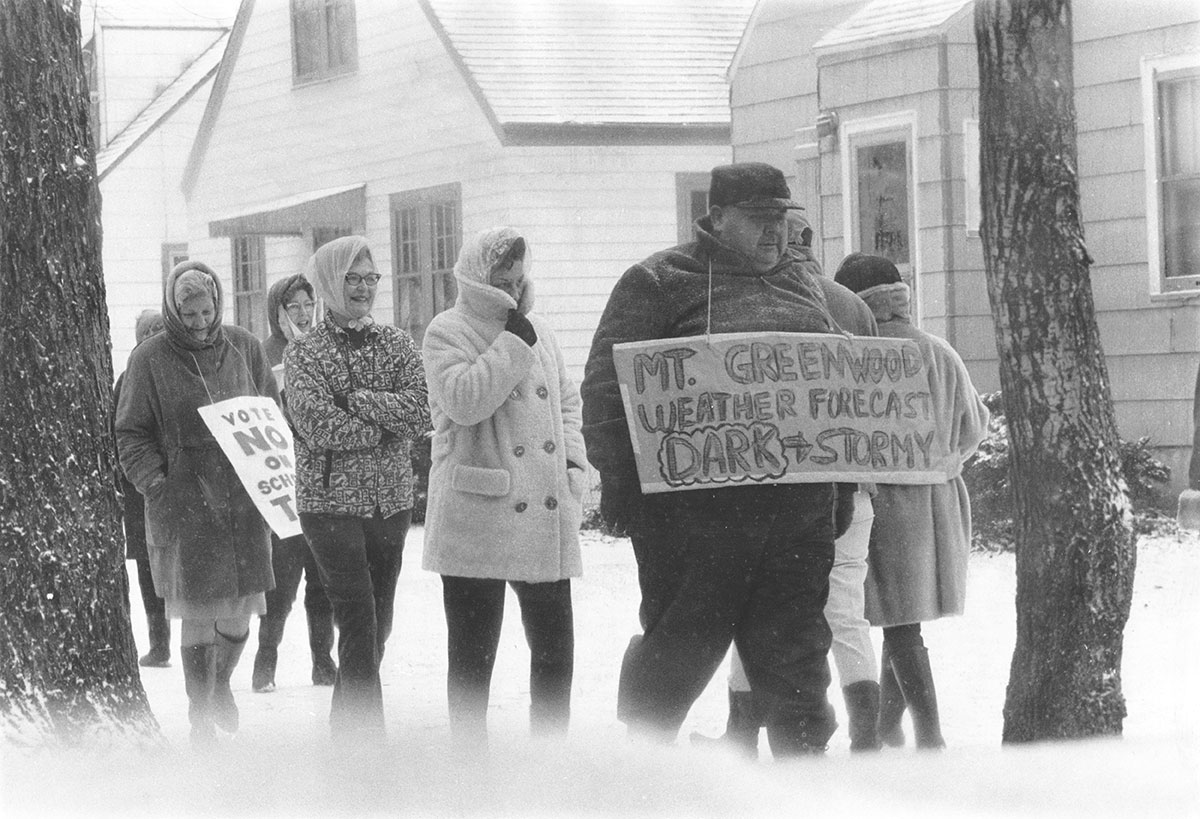
Anti-integration protestors picket outside Mount Greenwood on February 2, 1968, four days after eleven black students were admitted to the school.
On Monday the twenty-ninth, my parents and another couple were on hand at Mount Greenwood—as were an estimated two hundred and forty jeering demonstrators—as eleven black students and their parents arrived and were ushered through a phalanx of police. “Mom & Dad & Browns [Edward and Elizabeth Brown, two of the Justice group] went to the school,” I wrote in my diary that night. “There were a lot of pickets and Dad opened the car door for the parents & Mom wished them luck. They [the parents] were pretty nervous. The cops didn’t even move toward Dad.”
The demonstrators carried signs bearing slogans such as “protect the neighborhood schools” and “protest now or be sorry later.” (The next day’s picket signs were plainer: “let’s fight to keep our school white” and “mt. greenwood weather forecast: dark + stormy,” and a newspaper photo showed the school’s engineer trying to remove the words “white power” that someone had painted on the building.) The crowd fluctuated in size throughout the day, and became more vocal as school let out, shouting, “Don’t come back” and “Kill ’em!” Jeers were loudest from the white students leaving the building, with one boy telling a reporter, “I hate niggers. Write that down.” Still, the next day, Robert L. Reinsch, the superintendent of the local school district, told reporters there were “no problems inside the school.” By mid-February, the Chicago Daily News ran a picture of black and white girls playing double dutch on the playground.
Dad returned to Washington that first night, but he was back in Chicago before the end of the week, as demonstrations outside the school turned violent. On Wednesday, the black students’ third day at Mount Greenwood, two counter-demonstrators appeared: Terrence Burke and Will Leben, both twenty-four, both residents of the neighbouring community of East Beverly. Burke was still on Christmas break from the Cleveland college where he taught English, and Leben, who had only recently returned to the United States from a stint in Niger with the Peace Corps, was a graduate student in linguistics at Northwestern University. Their signs read, “support redmond’s plan for equal education” and “we’re marching for equality too long denied.” “For the first couple of circuits [on the sidewalk in front of the school], the [anti-integration] protesters said to us, ‘Nice to see some men out here!’ and ‘Good for you, boys!’—and then they actually read our signs,” Burke told me in 2016. “Then they decided to call us names: pinko, faggot. They started to try to grab the signs and then that escalated.”
A series of pictures by Duane Hall, a Chicago Sun-Times photographer, shows Leben being kicked from behind and then punched in the face by a woman. Another set of Hall’s published photos shows a burly man struggling to take Burke’s picket sign. In neither instance did Burke or Leben fight back, even as they were being strong-armed into unmarked cars by men they learned only later were plainclothes police officers, who took them to the district police station and charged them with disorderly conduct and resisting arrest. The photo of Leben being kicked and punched appeared in newspapers across the country. Dad saw it in Washington and returned home.
The day after Burke and Leben were attacked, a group of clergymen came to the school to counter-demonstrate. They also were assaulted, their signs torn up and stomped into the mud of the mid-winter thaw. This time, however, the police arrested two Mount Greenwood men, one of whom lived five doors away from us.
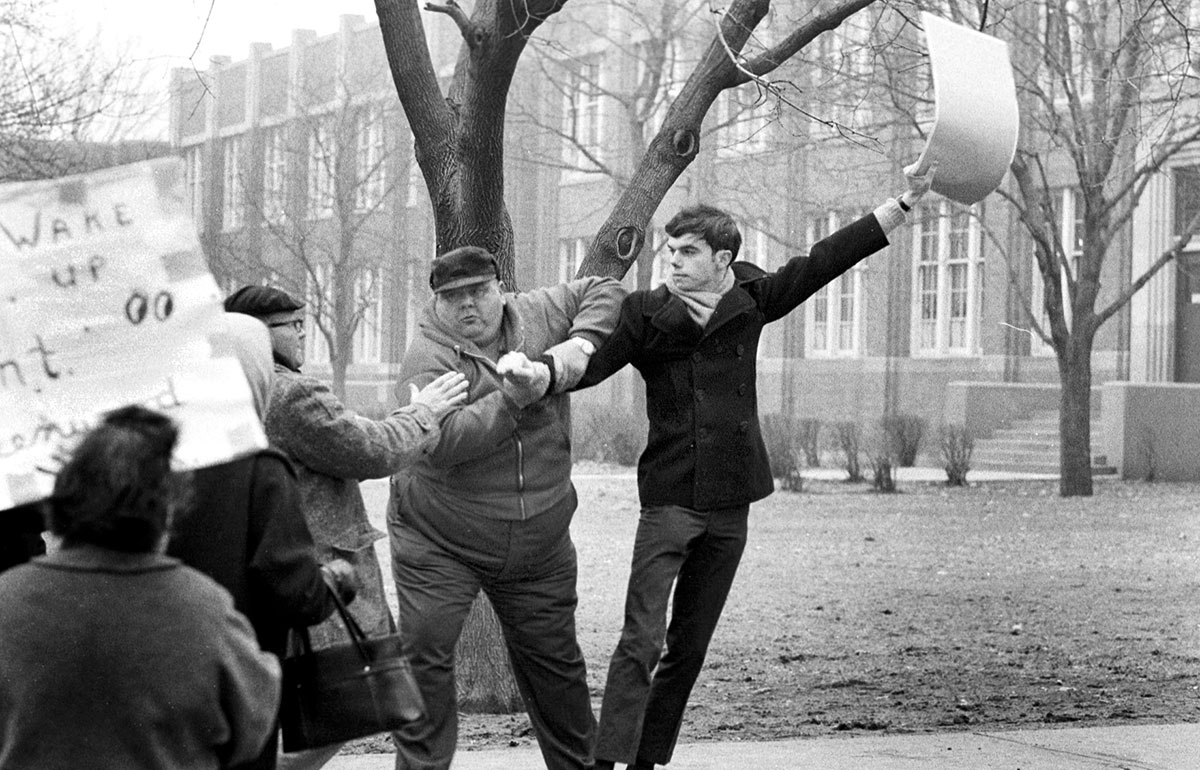
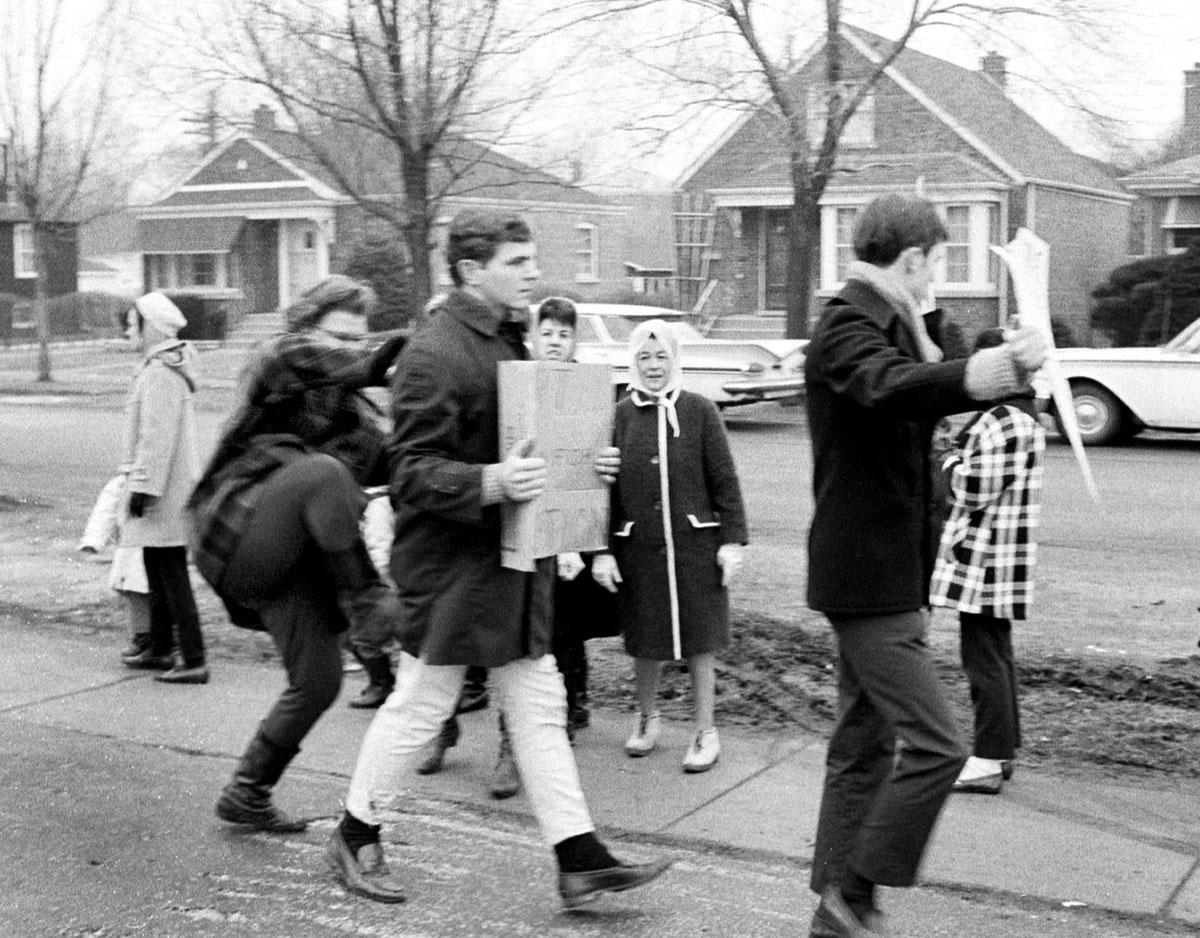
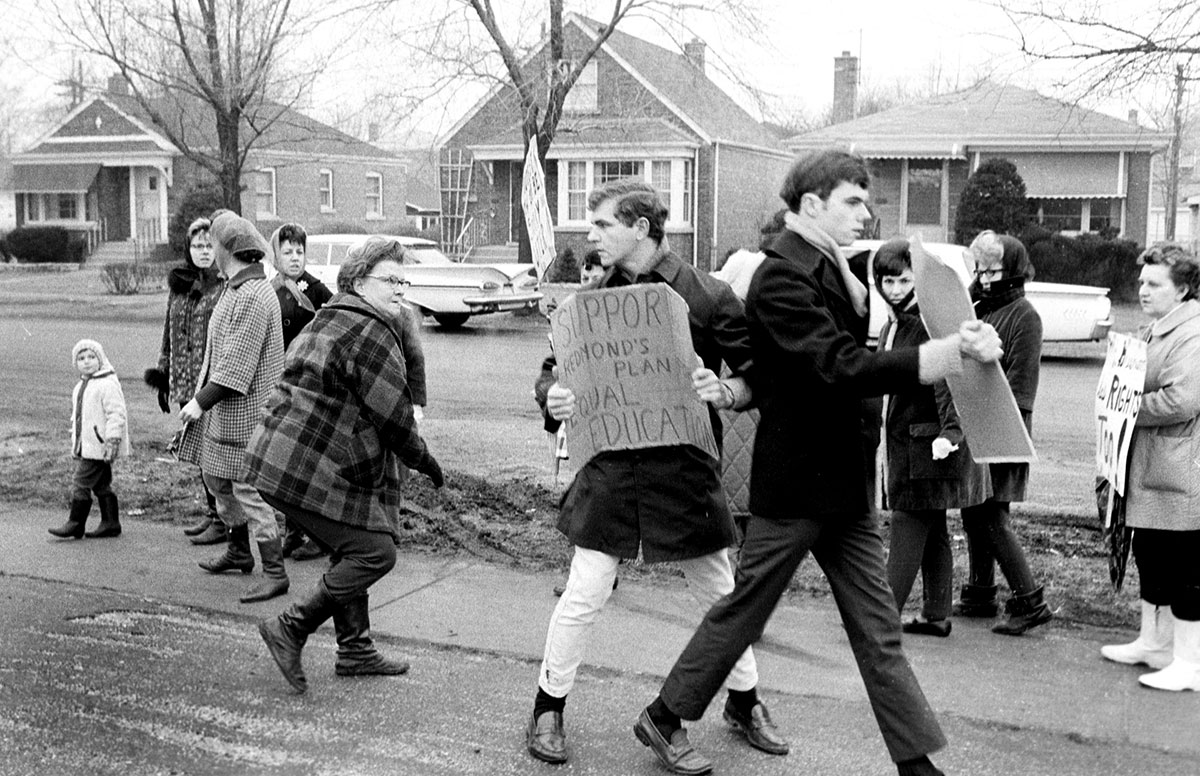

From top: An anti-integration protester attempts to grab a sign from the counter-demonstrator Terrence Burke on the third day of the Mount Greenwood transfer; Will Leben is kicked from behind and then punched by a protester.
The next day—Friday, the last day of that first school week—fifty counter-demonstrators arrived, including Albert Raby, a leading black civil-rights leader in Chicago. This time, police separated the anti-integration demonstrators and the counter-demonstrators. All picketing was to be done across the street instead of on the sidewalk immediately in front of the school. The two groups were assigned opposite ends of the block, with a buffer of uniformed police officers between them. However, that day, the children’s parents asked that the counter-demonstrations cease. The request came at a widely reported news conference, where the parents were represented by the Organization for the Southwest Community. “To counter-demonstrate only adds fuel to an already potentially explosive situation,” Anna Thomas, an organization spokeswoman, said. The parents asked that “persons who want to express their feelings of encouragement and their distaste for the present situation use some other methods than demonstrating.”
An O.S.C. news release was a bit more explicit: the group thanked “all well wishers for their support,” but added, “We feel the children are already heavily burdened and all that such action [counter-demonstrations] could accomplish would be to further complicate them.”
The families of four of the black students were frightened enough by the community’s response that, by this time, they had pulled their children from Mount Greenwood and returned them to their original schools. I noted in my diary that my mother and father met that evening with the parents of the seven black students who remained, to express their support. The next night, a handful of my parents’ Queen of Martyrs friends gathered at our house to discuss the week’s events.
The following week, counter-demonstrators returned. They numbered only between twenty and thirty, while the anti-integration marchers’ numbers rarely fell below a daily peak of one hundred. One group of counter-pickets explained, in a statement, their return despite the parents’ request: “All of us black and white know that Mt. Greenwood represents a crisis that has gone beyond community boundaries. White racists have chosen it as the battleground on which they hope to defeat any further steps towards quality, integrated education by Chicago’s reluctant Board of Education. We feel it would be callous and cowardly to leave this battle to the remaining Negro students and their courageous parents.”
On Monday of the second week, Mayor Daley weighed in, issuing a tepid call for calm and accusing the news media of inflaming the situation. “I would hope we can approach this situation in a reasonable and unemotional way,” he told a news conference. He then charged that newspaper, TV, and radio reporters had “greatly magnified” the seriousness of the picketing the week before.
The only violent incident recorded during the second week occurred when a fourteen-year-old boy threw a firecracker at counter-demonstrators. The firecracker exploded, apparently without injuring anyone, and the boy was arrested. The firecracker occurrence was documented by the Chicago Police Department’s Red Squad, members of which were on hand through most of the demonstrations at the school.
The squad’s files note the licence information for a yellow 1967 Ford Falcon van, marked “school bus,” that the black students’ parents had arranged to transport the children to and from the school starting in the second week. The files also reveal police harassment of the van’s driver. When anti-integration demonstrators saw the van, they shouted, “Check her [the driver’s] chauffeur’s licence!” But the van drove away before police could take any action, so the group spoke to the Red Squad commander on the scene. “citizens to have a police officer check & see that the F/N [female Negro], driving the Bus is properly licensed,” the Red Squad report read, with the name of the commander blacked out. The next day’s report noted that Sgt. Norris of the Sixth District (Gresham) “verified that she had a valid driver’s license.”

A Mount Greenwood engineer removes hate graffiti painted onto the school’s outer wall.
The Red Squad reports on the Mount Greenwood integration are also rife with automobile licence-plate numbers and identifications for counter-demonstrators arriving at the school, but they fail to note my mother’s 1962 Rambler Ambassador. Admittedly, it was a grey car, easily overlooked—except that it was parked across the street from the school every day of the demonstrations, while my mother observed what went on. It would also have been hard to miss one day when my sister Roxe accompanied her, and the anti-integration demonstrators altered their route in order to picket my mother’s car. “They did a couple of circuits around the car,” Roxe, who was eleven at the time, told me. “Mom said to just relax. It was kind of scary, but kind of funny.” The marchers were menacing because of their number—Roxe didn’t remember how many there were, but said it was probably fifteen to twenty, enough to surround the car—and their shouting, but those same qualities made Roxe bemused: “Here were these screaming grownups, who were supposed to know better than to get that upset. There was no threat. We weren’t doing anything threatening. We were just sitting there, keeping an eye on things. And these were just children who had come to the school. They were no threat either.”
The anti-integration demonstrations lasted the first two weeks the black students were at Mount Greenwood, and then on only two other dates. On February 14th, about one hundred and thirty picketers appeared with signs that read “parent power,” but “none of the signs had any racial overtones,” the Red Squad report stated. The last reported demonstration was held nearly three weeks later, on March 4th, when about thirty parents made a last stand against the presence of the seven remaining black students.
I was appalled in equal measure by the actions of my neighbours at the school and by the inaction of clergy at Queen of Martyrs, who failed to recognize a “preachable moment” and strongly remind the congregation of the fundamental commandment of Christianity to love thy neighbour. I put my feelings in rhyme and submitted them to the poetry column of the New World, the Catholic weekly newspaper, where it was published in mid-April. The language is clearly that of a thirteen-year-old Catholic girl of the day, but my disillusionment is still palpable:
In ’68 toward the end of Jan.,
Some Negro kids came to Greenwood on the transfer plan.
On their first day there, at the school,
They found that the townsfolk didn’t think it was cool.
This is racial prejudice. Of this I’m sure.
But for this prejudice, isn’t there any cure?
At another school not far from there,
Nothing was said. I guess they don’t care.
The clergy’s supposed to lead us to unity
And help us all become one family.
This means everybody: black and white,
Red and yellow. Will they see the light?
Better act now before it’s too late
Or face up to the problems that you now await.
Too long in bondage without liberty,
Everyone deserves the right to be free.
Free to live in the one family,
Free to contribute to unity.
Love everybody is what Christ said.
If you don’t love everybody you’re as good as dead.
Chicago’s daily newspapers, as well as major publications aimed at a black readership, compared the two weeks of raucous, occasionally violent demonstrations in Mount Greenwood with the unrest that accompanied the desegregation of Little Rock Central High School, in Little Rock, Arkansas, in 1957, and two elementary schools in New Orleans, Louisiana, in 1960. These comparisons don’t really hold when you consider the larger scale and more severe violence that accompanied the Southern integrations. In addition, school attendance was disrupted: Arkansas Governor Orval Faubus actually closed the four Little Rock high schools for the 1958–59 academic year rather than continue with desegregation, and many white parents pulled their children from the newly desegregated McDonogh 19 and William Frantz elementary schools, in New Orleans, and enrolled them in private schools. A letter to the editor of a community newspaper captured what did make the Mount Greenwood case notable: “One would have not expected a northern ‘Little Rock,’ so many years after the southern incidents rocked the country.”
Manifestations of racism in Chicago, specifically on the South Side, could be remarkably vicious. When Martin Luther King, Jr., was hit in the head with a rock during an open-housing demonstration, in 1966, in Marquette Park—another all-white neighbourhood on the Southwest Side, about forty blocks due north of Mount Greenwood—he said, “I have been in the civil-rights movement for many years all through the South, but I have never seen—not even in Alabama or Louisiana—mobs as hostile and hateful as this crowd.”
The levels of hostility and barely suppressed violence that greeted the handful of black children who came to Mount Greenwood startled even long-time observers of the racial tensions in Chicago. “It was Little Rock and New Orleans all over again in the Windy City, where white parents reacted in Dixie-like fashion to the prospect of school integration,” said a writer in the Chicago Daily Defender, an influential black newspaper. An editorial in Ebony magazine juxtaposed a photo of screaming demonstrators in 1960 New Orleans with one of their counterparts in 1968 Chicago. The two sets of faces, deformed by hate, were virtually indistinguishable, as were their “songs”:
The tune is the same—and so are the words. Only the singers differ in time and place. They are usually mothers, housewives, and of early middle age or younger. They are always white. Often they carry pre-school age children in their arms or push babies in carriages as they perform. “Nigger, nigger, nigger!” “Go back to the zoo.” “We don’t want you.” “Kill them!” The voices are shrill, the faces contorted. . . .
Once thought of as a Southern folk song, the words and tune were highly popular throughout the South from Little Rock to Charlotte, from New Orleans to Nashville as Southern school boards attempted to follow the direction of the Supreme Court after the 1954 school decision which ruled that separate education is unequal education. But today the locale has been changed. The women who picketed a group of seven Negro children who integrated the Mount Greenwood Elementary School in Chicago in February, 1968 have much in common with the women of New Orleans who shouted derisive remarks at a lone Negro integrating Frantz School in November 1960.
The editorial called on “responsible citizens, both black and white,” to abolish “deep-running racism,” inequity, and discrimination, and, it added, “they had better begin to act right now.” During the time Ebony’s editorial—titled “Could It Be Too Late?”—sat on newsstands, Martin Luther King, Jr., was murdered, and black ghettoes in more than a hundred American cities had erupted into violence, looting, and destruction.